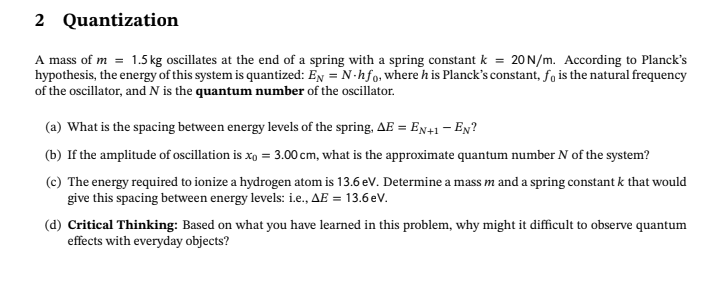A mass of m= 1.5 kg oscillates at the end of a spring with a spring constant k = 20 N/m. According to Planck's hypothesis, the energy of this system is quantized: EN=N-hfo, where h is Planck's constant, fo is the natural frequency of the oscillator, and N is the quantum number of the oscillator. (a) What is the spacing between energy levels of the spring, AE = EN+1-EN? (b) If the amplitude of oscillation is xo = 3.00 cm, what is the approximate quantum number N of the system? (c) The energy required to ionize a hydrogen atom is 13.6 eV. Determine a mass m and a spring constant k that would give this spacing between energy levels: i.e., AE = 13.6 eV. (d) Critical Thinking: Based on what you have learned in this problem, why might it difficult to observe quantum effects with everyday objects?
A mass of m= 1.5 kg oscillates at the end of a spring with a spring constant k = 20 N/m. According to Planck's hypothesis, the energy of this system is quantized: EN=N-hfo, where h is Planck's constant, fo is the natural frequency of the oscillator, and N is the quantum number of the oscillator. (a) What is the spacing between energy levels of the spring, AE = EN+1-EN? (b) If the amplitude of oscillation is xo = 3.00 cm, what is the approximate quantum number N of the system? (c) The energy required to ionize a hydrogen atom is 13.6 eV. Determine a mass m and a spring constant k that would give this spacing between energy levels: i.e., AE = 13.6 eV. (d) Critical Thinking: Based on what you have learned in this problem, why might it difficult to observe quantum effects with everyday objects?
Related questions
Question

Transcribed Image Text:2
Quantization
A mass of m= 1.5 kg oscillates at the end of a spring with a spring constant k = 20 N/m. According to Planck's
hypothesis, the energy of this system is quantized: EN = N-hfo, where his Planck's constant, fo is the natural frequency
of the oscillator, and N is the quantum number of the oscillator.
(a) What is the spacing between energy levels of the spring, AE = EN+1-EN?
(b) If the amplitude of oscillation is xo = 3.00 cm, what is the approximate quantum number N of the system?
(c) The energy required to ionize a hydrogen atom is 13.6 eV. Determine a mass m and a spring constant k that would
give this spacing between energy levels: i.e., AE = 13.6 eV.
(d) Critical Thinking: Based on what you have learned in this problem, why might it difficult to observe quantum
effects with everyday objects?
Expert Solution
This question has been solved!
Explore an expertly crafted, step-by-step solution for a thorough understanding of key concepts.
Step by step
Solved in 6 steps
